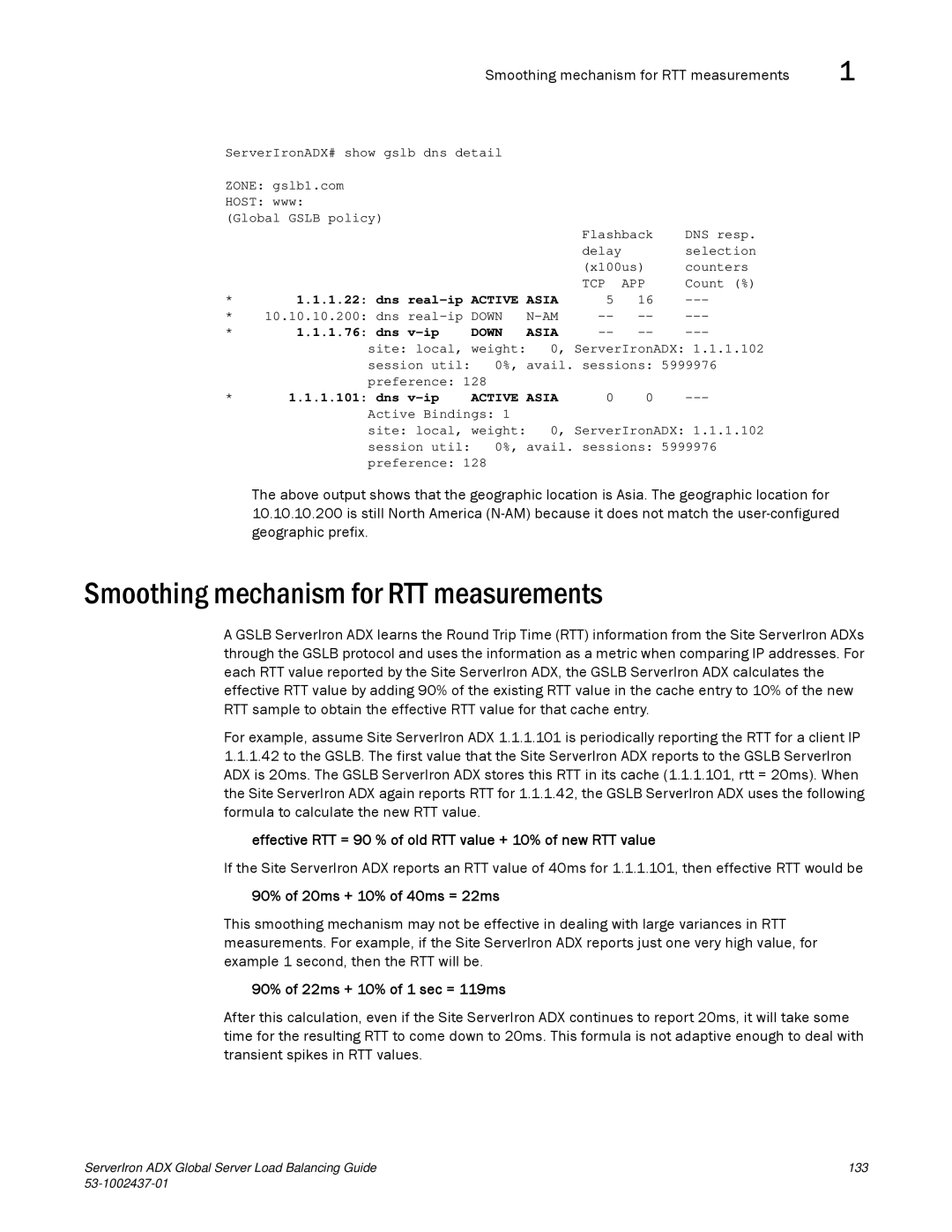Smoothing mechanism for RTT measurements | 1 |
ServerIronADX# show gslb dns detail |
|
|
|
| ||
ZONE: gslb1.com |
|
|
|
|
| |
HOST: www: |
|
|
|
|
| |
(Global GSLB policy) |
|
| Flashback | DNS resp. | ||
|
|
|
| |||
|
|
|
| delay |
| selection |
|
|
|
| (x100us) | counters | |
* | 1.1.1.22: dns | TCP | APP | Count (%) | ||
5 | 16 | |||||
* | 10.10.10.200: dns | |||||
* | 1.1.1.76: dns | DOWN | ASIA | |||
| site: local, | weight: | 0, ServerIronADX: 1.1.1.102 | |||
| session util: | 0%, | avail. sessions: 5999976 | |||
* | preference: 128 | ASIA | 0 | 0 | ||
1.1.1.101: dns | ACTIVE | |||||
| Active Bindings: 1 | 0, ServerIronADX: 1.1.1.102 | ||||
| site: local, | weight: | ||||
| session util: | 0%, | avail. sessions: 5999976 | |||
preference: 128
The above output shows that the geographic location is Asia. The geographic location for 10.10.10.200 is still North America
Smoothing mechanism for RTT measurements
A GSLB ServerIron ADX learns the Round Trip Time (RTT) information from the Site ServerIron ADXs through the GSLB protocol and uses the information as a metric when comparing IP addresses. For each RTT value reported by the Site ServerIron ADX, the GSLB ServerIron ADX calculates the effective RTT value by adding 90% of the existing RTT value in the cache entry to 10% of the new RTT sample to obtain the effective RTT value for that cache entry.
For example, assume Site ServerIron ADX 1.1.1.101 is periodically reporting the RTT for a client IP
1.1.1.42to the GSLB. The first value that the Site ServerIron ADX reports to the GSLB ServerIron ADX is 20ms. The GSLB ServerIron ADX stores this RTT in its cache (1.1.1.101, rtt = 20ms). When the Site ServerIron ADX again reports RTT for 1.1.1.42, the GSLB ServerIron ADX uses the following formula to calculate the new RTT value.
effective RTT = 90 % of old RTT value + 10% of new RTT value
If the Site ServerIron ADX reports an RTT value of 40ms for 1.1.1.101, then effective RTT would be
90% of 20ms + 10% of 40ms = 22ms
This smoothing mechanism may not be effective in dealing with large variances in RTT measurements. For example, if the Site ServerIron ADX reports just one very high value, for example 1 second, then the RTT will be.
90% of 22ms + 10% of 1 sec = 119ms
After this calculation, even if the Site ServerIron ADX continues to report 20ms, it will take some time for the resulting RTT to come down to 20ms. This formula is not adaptive enough to deal with transient spikes in RTT values.
ServerIron ADX Global Server Load Balancing Guide | 133 |
|
